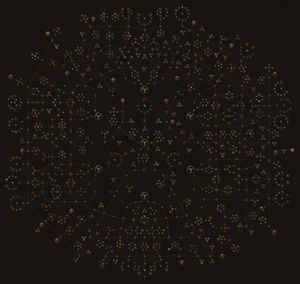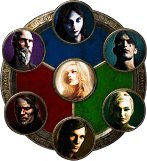Passive skill: Difference between revisions
>KLIKS (→Keystone Passives: Added Elemental Overload) |
>KLIKS (→Keystone Passives: Added Elemental Overload) |
(No difference)
| |
Revision as of 11:31, 8 April 2016

Every character in Path of Exile has access to the passive skill tree [1]. The passive skill 'tree' is a large network of stats and raw attributes increases for the player's character. All classes are on the same tree, but start in different places. When a character levels up or completes certain quests, he gains one skill point. That point can be used to activate a node, but the tree must be connected to that node. This is how the character's passive 'path' is formed.
Characters can accrue 99 skill passive points from levels and 21-24 skill points from quests, depending on the choices you make in the quest Deal with the Bandits.
While the passive tree (sometimes referred to in-game as the Skilldrasil or Skill Web) may seem complicated, it actually only has two parts. It can be thought of as a map, with suburbs and roads.
The clusters of related passive nodes that boost a specific area (swords, maces, archery, damage types, evasion, and so on) are like suburbs. These will form the bulk of a character's build. The pathways between these clusters, comprised entirely of nodes that give +10 to a certain attribute, are like roads. Some of these roads can cover a great distance much quicker than if the player detours through the suburbs: what may look like a short path with passive boosts could in fact be much longer than taking the +10 to attribute path.
Pressing 'c' in-game and hovering over each of the three attributes will show what these do. Anything the attributes don't do, such as increase ranged damage or attack speed, will likely be handled by passive nodes on the skill 'tree'.
Layout
- The tree can be divided into three primary sectors of equal size, one third of the relatively circular tree, surrounding a central wheel. They are the north or blue sector, the southwest or red sector and the southeast or green sector.
- The north or blue sector is also known as the magic sector; passives there boost intelligence, elemental damage, energy shield, wand damage, minion stats, etc...everything related to magic, and the skills normally found on blue gems.
- The southwest or red sector is also known as the melee sector; passives there boost strength, armor, physical damage and nearly every known aspect of melee combat, as well as all skills normally found on red gems.
- The southeast or green sector is also known as the Ranged sector; passives there boost dexterity, ranged projectile damage, evasion, most known aspects of ranged combat and all skills normally found on green gems.
- As the player moves to the borders between sectors the passive skills available there become more hybridized between the two.

- When a new game is started, each character starts at the border of the inner wheel of the tree at a different location; the Witch for example starts at the due-north border of the inner wheel, smack in the middle of the blue sector showing her preference for magic. The wheel of character images (on the right) shows which position each class starts in and therefore their preferred method of combat; the Marauder starts in the middle of the red sector showing a preference for melee combat and the Ranger starts in the middle of the green sector for ranged combat, with the other characters starting in a position to put them in more of a hybrid role to start.
- Although it takes some extra skill points to do this, there is nothing stopping the player from choosing passives to quickly get into a different sector than his character started out with to, for example, make a melee-combat Witch, given that there are no set equipment limits on which character can equip what other than what their passive stats allow. However, keep in mind that the campaign quests that give skill gems as rewards give gems related to the natural preference of that character, i.e. the Witch will usually only see magic-type gems. So even though making a non-standard character is possible it really isn't recommended other than for show.
Making builds
There is also an offline-ish skill tree that can be downloaded from the forums, which allows players to refine their intended builds more easily. This program needs internet access to download the skill tree from pathofexile.com, but only needs to do this once (and whenever the skill tree is changed by patches).
Passive Nodes
Basic Passives
Notable Passives
For a list of all notables, see Category:Notable passive skills.
Notable passives can also be found on the pages of the stats they affect:
- Accuracy
- Attack Speed
- Area of Effect
- Armour
- Aura
- Axes
- Bleed
- Block Chance
- Bows
- Cast Speed
- Chaos Damage
- Charges
- Claws
- Cold Damage
- Critical Strike
- Critical Strike for Spells
- Curses
- Daggers
- Damage over time
- Dodge
- Dual Wielding
- Elemental Damage
- Energy Shield
- Evasion
- Fire Damage
- Flasks
- Fortify
- Gain on hit
- Gain on kill
- Leech
- Life
- Lightning Damage
- Maces
- Mana
- Mana reservation
- Mines
- Minions
- Movement Speed
- One-Handed Melee Weapons
- Melee Physical Damage
- Poison
- Projectiles
- Scepters
- Mines
- Regeneration
- Resistances
- Shields
- Skill Duration
- Spell Damage
- Status Ailments
- Staves
- Stun
- Swords
- Totems
- Traps
- Two-Handed Melee Weapons
- Wands
Jewel sockets
Jewel sockets are nodes on the skill tree that can be filled with jewels. By default, they are empty and don't grant any bonuses. A jewel socket must be allocated first before a jewel can be placed in it. There are currently 21 sockets distributed around the tree. There is no cap on the amount of sockets the player can allocate.
Keystone Passives
- Acrobatics and Phase Acrobatics
- Ancestral Bond
- Arrow Dancing
- Avatar of Fire
- Blood Magic
- Chaos Inoculation
- Conduit
- Eldritch Battery
- Elemental Equilibrium
- Elemental Overload
- Ghost Reaver
- Iron Grip
- Iron Reflexes
- Necromantic Aegis
- Pain Attunement
- Point Blank
- Mind over Matter
- Minion Instability
- Resolute Technique
- Unwavering Stance
- Vaal Pact
- Zealot's Oath